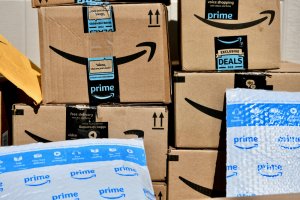 For years, fulfillment companies and on-line marketers have left it to the consumer to dispose of their delivery packaging, mostly cardboard and plastic. In the days before the virus, when most consumers would leave their homes and physically shop, they first got paper bags, then plastic bags, to transport their purchases home. After plastic bags became ubiquitous and their ability to be recycled became dubious, their use was systematically banned for environmental reasons. Soon, it was bring your own reusable bag or pay for a paper one. People brought their own. Suddenly reusable bags were everywhere!
For years, fulfillment companies and on-line marketers have left it to the consumer to dispose of their delivery packaging, mostly cardboard and plastic. In the days before the virus, when most consumers would leave their homes and physically shop, they first got paper bags, then plastic bags, to transport their purchases home. After plastic bags became ubiquitous and their ability to be recycled became dubious, their use was systematically banned for environmental reasons. Soon, it was bring your own reusable bag or pay for a paper one. People brought their own. Suddenly reusable bags were everywhere!
The Virus Boosts Home Delivery
But then came the virus and people were not only sheltering in place, and many of us were afraid to go out and shop. During these times, for sanitary reasons, reusable bags are out of favor at grocery stores and other retail stores. Paper bags came back in a hurray!
But as more people discovered the convenience of home delivery of just about everything, there was a sea change in consumer retail. Throngs of consumers quickly joined the movement toward e-commerce. On-line shopping exploded, and with it, cardboard boxes and bubble wrap. These quickly became the most common type of refuse. With the “convenience” came tons of unwanted cardboard boxes and bubble wrap.
Drowning in a Sea of Boxes
Now, instead of one reusable bag with 20 items in it from one store, you got 20 different boxes at your door. Instead of getting a box once in a while with that on-line order, now you started getting boxes several times a week. What to do with all the cardboard boxes and bubbly wrap?
And who is the biggest culprit for dumping cardboard boxes and bubbly wrap on the consumer to dispose of? The biggest on-line retailer and fulfillment house, of course: Amazon.
The End of “Free” Packaging Disposal
Up until recently, CPG product producers, on-line retailers, and fulfillment houses have banked on their history of shirking the responsibility for the disposal of their delivery packaging. That was left up to the consumer.
That is until last Sunday. On the back page of the A section of the San Francisco Chronicle was a full page ad paid for by the “Committee, Amazon to Reuse Boxes Initiative,” a Marin County, California, advocacy group.
An Open Letter
In quarter-inch high font, “An Open Letter to Jeff Bezos Regarding the Amazon to Reuse Boxes Initiative” was hard to miss! Stretching across the entire page from top to bottom, 10 inches by 20 inches, 30 plus lines of text spelled out the beginning of the end of an era. The era is the one where the packaging implications of home delivery is borne by the consumer. If the “committee” has their way, that will change.
The open letter was well written, with respect and decorum sadly missing in most advocacy today. It started out thanking Jeff Bezos for “enabling millions of people to access critical supplies” during these critical times. But it was quick to point out how “the convenience that we love about Amazon is creating and environmental issue,” alluding to the packaging disposal challenge.
Win-Win-Win
Then the letter succinctly offers a solution that appears to be a win-win-win: “The program would ask for delivery trucks to collect Amazon boxes and plastic mailers on subsequent deliveries and take them back to Amazon warehouses for reuse.” Wow! Is that simple?!
The letter goes on to cite the program’s endorsement by 10 Marin County cities, the County Board of Supervisors, the US Congressman representing the county, the county’s largest businesses, and over 10,000 residents. It offers up Marin County as a pilot for the “Pick Up Program.”
And we love this part: “Because it’s a tree saver, a water conserver, a cost eliminator, a waste reducer, and an efficiency enhancer, it would help Marin County achieve its zero waste goals while enhancing Amazon’s reputation as a community-minded partner. There’s no downside.”
A New Paradigm
We are sure that Amazon will have some costs in the program, at least in terms of logistics and retooling for recycling or the development of returnable standard packaging options. But even so, in the long run, Amazon can really start the revolution in the formerly “one-way” packaging practices by picking up what they drop off.
They certainly already have the home visit logistics and infrastructure down. They are already at your door on a regular basis. Why not take their packaging back, and reuse it? In fact, why not create an industry for multiple-use standard packaging like the milkman used to have in the 1950’s?
We think this initiative is just the tip of the iceberg where we will start seeing consumers rebelling against being stuck with packaging materials. The days of “free” packaging disposal for producers, retailers, and fulfilment houses are numbered. The box stops here!
For more information on this initiative, visit: https://www.facebook.com/amazontoreuseboxes/
